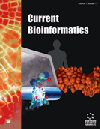- Home
- A-Z Publications
- Current Bioinformatics
- Previous Issues
- Volume 14, Issue 6, 2019
Current Bioinformatics - Volume 14, Issue 6, 2019
Volume 14, Issue 6, 2019
-
-
Computational Approaches to Predict the Non-canonical DNAs
More LessAuthors: Nazia Parveen, Amen Shamim, Seunghee Cho and Kyeong K. KimBackground: Although most nucleotides in the genome form canonical double-stranded B-DNA, many repeated sequences transiently present as non-canonical conformations (non-B DNA) such as triplexes, quadruplexes, Z-DNA, cruciforms, and slipped/hairpins. Those noncanonical DNAs (ncDNAs) are not only associated with many genetic events such as replication, transcription, and recombination, but are also related to Read More
-
-
-
A New Approach for Predicting the Value of Gene Expression: Two-way Collaborative Filtering
More LessAuthors: Tuncay Bayrak and Hasan OğulBackground: Predicting the value of gene expression in a given condition is a challenging topic in computational systems biology. Only a limited number of studies in this area have provided solutions to predict the expression in a particular pattern, whether or not it can be done effectively. However, the value of expression for the measurement is usually needed for further meta-data analysis. Methods: Because the problem Read More
-
-
-
Performance Improvement of Gene Selection Methods using Outlier Modification Rule
More LessAuthors: Md. Shahjaman, Nishith Kumar and Md. N. H. MollahBackground: DNA microarray technology allows researchers to measure the expression levels of thousands of genes simultaneously. The main objective of microarray gene expression (GE) data analysis is to detect biomarker genes that are Differentially Expressed (DE) between two or more experimental groups/conditions. Objective: There are some popular statistical methods in the literature for the selection of biomarker ge Read More
-
-
-
GMSA: A Data Sharing System for Multiple Sequence Alignment Across Multiple Users
More LessBackground: In recent years, the rapid growth of biological datasets in Bioinformatics has made the computation of Multiple Sequence Alignment (MSA) become extremely slow. Using the GPU to accelerate MSA has shown to be an effective approach. Moreover, there is a trend that many bioinformatic researchers or institutes setup a shared server for remote users to submit MSA jobs via provided web-pages or tools. Obje Read More
-
-
-
Combining Sequence Entropy and Subgraph Topology for Complex Prediction in Protein Protein Interaction (PPI) Network
More LessAuthors: Aisha Sikandar, Waqas Anwar and Misba SikandarBackground: Complex prediction from interaction network of proteins has become a challenging task. Most of the computational approaches focus on topological structures of protein complexes and fewer of them consider important biological information contained within amino acid sequences. Objective: To capture the essence of information contained within protein sequences we have computed sequence entropy Read More
-
-
-
RMDB: An Integrated Database of Single-cytosine-resolution DNA Methylation in Oryza Sativa
More LessAuthors: Tiansheng Zhu, Jihong Guan, Hui Liu and Shuigeng ZhouBackground: Previous studies have revealed that DNA methylation plays a crucial role in eukaryotic growth and development via involvement in the regulation of gene expression and chromosomal instability. With the advancement of biotechnology, next-generation sequencing (NGS) is emerging as a popular method to explore the functions of DNA methylation, and an increasing number of genome-scale DNA methylation dataset Read More
-
-
-
Proteome Mining for the Identification of Putative Drug Targets For Human Pathogen Clostridium Tetani
More LessAuthors: Anum Munir, Shaukat I. Malik and Khalid Akhtar MalikBackground: Clostridium tetani are rod-like, anaerobic types of pathogenic bacteria of the genus Clostridium. It is Gram-positive in nature and appears as a tennis racket or drumsticks on staining with the dye. Tetanus is a neuromuscular disease wherein the Clostridium tetani exotoxin produces muscle fits in the host. Tetanus is the second leading cause of worldwide deaths occurring from the family of immunization-pre Read More
-
-
-
A Therapeutic Approach Against Leishmania donovani by Predicting RNAi Molecules Against the Surface Protein, gp63
More LessAuthors: Farhana T. Chowdhury, Mohammad U.S. Shohan, Tasmia Islam, Taisha T. Mimu and Parag PalitBackground: Leishmaniasis is a disease caused by the Leishmania sp. and can be classified into two major types: cutaneous and visceral leismaniasis. Visceral leishmaniasis is the deadlier type and is mediated by Leishmania donovani and involves the establishment of persistent infection and causes damage to the liver, spleen and bone marrow. With no vaccine yet available against leishmaniasis and the current t Read More
-
-
-
Adaptive Elman Model of Gene Regulation Network Based on Time Series Data
More LessAuthors: Shengxian Cao, Yu Wang and Zhenhao TangBackground: Time series expression data of genes contain relations among different genes, which are difficult to model precisely. Slime-forming bacteria is one of the three major harmful bacteria types in industrial circulating cooling water systems. Objective: This study aimed at constructing gene regulation network(GRN) for slime-forming bacteria to understand the microbial fouling mechanism. Methods: For this purpose, an Read More
-
Volumes & issues
-
Volume 20 (2025)
-
Volume 19 (2024)
-
Volume 18 (2023)
-
Volume 17 (2022)
-
Volume 16 (2021)
-
Volume 15 (2020)
-
Volume 14 (2019)
-
Volume 13 (2018)
-
Volume 12 (2017)
-
Volume 11 (2016)
-
Volume 10 (2015)
-
Volume 9 (2014)
-
Volume 8 (2013)
-
Volume 7 (2012)
-
Volume 6 (2011)
-
Volume 5 (2010)
-
Volume 4 (2009)
-
Volume 3 (2008)
-
Volume 2 (2007)
-
Volume 1 (2006)
Most Read This Month
Article
content/journals/cbio
Journal
10
5
false
en


